Buttington is a village in Montgomeryshire, situated just over a mile from Welshpool, in the community of Trewern. The Montgomery Canal passes through the village, and the River Severn runs nearby. Historically, at Buttington in 893 a combined Welsh and Mercian army under Æthelred, Lord of the Mercians, defeated a Danish army which had marched from Essex, and was the decisive battle in the war against the Viking invasion of the 890s.The men of Buttington and Trewern who fell during both World Wars are commemorated on a number of war memorials locally. The main war memorial is located in the Churchyard of the Church of All Saints at Buttington, whilst there is another memorial in the Church, plus the men are commemorated on additional panels on the Welshpool war memorial, which commemorate the fallen of the neighbouring Parishes.
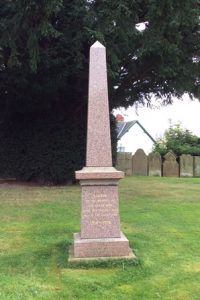
The Great War, 1914-1918
William John Bebb, Private, 39145, Lancashire Fusiliers. William was born in Buttington in 1884, the son of Maurice Bebb and Elizabeth Bebb (nee Ford), of The Pheasant Inn. His father died when he was six years old, and by the age of 16, William was residing at 47, High Street, Welshpool, where he worked as a Grocer’s Apprentice. William was living in Liverpool when war broke out, and enlisted there into the Lancashire Fusiliers on 6 December 1915. He married Isabella Mabel Hamlet at St. Dunstan’s, Edge Hill whilst on leave on 20 March 1917. During the summer of 1917 William embarked for France, joining the 2/7th Battalion, Lancashire Fusiliers. The battalion was attached to 197 Brigade, 66th (East Lancs) Division, and had landed in France on 28 February 1917, moving to the Flanders Coast, to prepare for a potential assault. At the end of September 1917, the Passchendaele offensive had become bogged down in the mud, so the Division was moved to Ypres, taking part in the Battle of Poelcapelle. The Division then moved south to the Somme, and on 21 March 1918 was hit hard when the German’s launched the first phase of their Spring Offensive, and saw heavy casualties as it was forced to withdraw over the coming days. The Division suffered so badly, that it was reduced to a training cadre. William had survived the fighting, but his health had broken down, and he was discharged from the army as medically unfit on 29 October 1918, returning to his wife in Liverpool. He died just four months later, on 10 February 1919. The 34-year-old was buried in Toxteth Park Cemetery, Liverpool four days later. William is not commemorated by the CWGC.
William Davies, Private, 39991, Royal Welsh Fusiliers. William was born at Buttington on 20 February 1885, the son of David and Ann Davies. The family later owned Cwmbychan Farm, Leighton, and William worked for his father there prior to gaining work as a Labour Master at the Union Workhouse in Stafford prior to the war. William enlisted into the Royal Welsh Fusiliers at Stafford on 12 February 1916, and was initially placed on the Army Reserve. He was mobilised on 18 April, joining the 3rd Battalion, Royal Welsh Fusiliers at Litherland Camp, Liverpool. William embarked for France at Southampton on 11 May 1917, and joined the 5th Infantry Base Depot at Rouen, before being posted to the 2nd Battalion, Royal Welsh Fusiliers, joining the battalion at Bailleulval on 3 June 1917. The battalion was attached to 19 Brigade, 33rd Division, and had just been relieved from the Arras sector, where it had spent several months fighting on the Hindenburg Line. On 19 June the 2nd RWF moved into the Moyenville sector, to begin a routine spell in the trenches, but at the end of the month, the entire Division was relieved, before moving to the Airaines area by 5 July, where it carried out a training scheme before the Division transferred to the Channel coast, near Bray Dunes, to prepare for a possible offensive along the coast. At the end of the month, on 31 July 1917, the Allies launched the Passchendaele offensive, intending to break out of the Ypres Salient, but after initial gains, the offensive bogged down in the Flanders mud, and the coastal operation was called off. The 33rd Division was transferred to the Ypres Salient, reaching Kenora Camp by 20 September, and on 23 September the 2nd RWF sent 300 men into the front lines to carry out trench construction and consolidation work, before the battalion took over the line facing Polygon Wood on 25 September. On the following morning, 26 September 1917, the battalion attacked Polygon Wood, moving off from its positions at Stirling Castle at 10.00, passing Glencorse Wood and proceeded to Black Watch Corner before forming up ready to attack by 11.45. Over 200 casualties were suffered by the battalion during the assault, amongst which was William, who had been killed in action during the day. The 32-year-old was originally buried on the battlefield, but his grave was exhumed in 1927, and his remains identified by his service number on his boots and army spoon, before he was re-interred in Sanctuary Wood Cemetery, Belgium on 19 April 1927.
David Charles Evans. David cannot presently be identified.
Thomas George France, Private, 43997, Royal Welsh Fusiliers. Thomas was the son of Thomas France and Jane France (nee Salter), of Green Lane Cottage, Trewern. He worked as a Cowman prior to enlisting into the 12th Battalion, Royal Welsh Fusiliers at Welshpool on 22 February 1916, and after completing his training, embarked for France at Southampton on 4 January 1917, joining the 5th Infantry Base Depot at Rouen. Thomas was posted to the 19th Battalion, Royal Welsh Fusiliers, which was attached to 119 Brigade, 40th (Bantam) Division, but within weeks he had been hospitalised back to England, aboard the Hospital Ship Dunluce Castle. He returned to France on 11 May 1917, initially to join the 9th Battalion, Royal Welsh Fusiliers, but on 2 June 1917 was posted back to the 19th Battalion, Royal Welsh Fusiliers. By now the 40th Division was on the Hindenburg Line, and on 23 November launched its famous assault on Bourlon Wood, suffering terrible casualties before being withdrawn. The Division remained in the area over the coming months, but became caught up in heavy fighting during the first phase of the German Spring Offensive of 21 March 1918. Due to the terrible casualties suffered by the Division, it was sent north to Flanders to rest and rebuild, but on 9 April the Germans launched the second phase of their offensive in Flanders, and the 40th Division was caught up in the thick of it again. Due to excessive losses, the Division was reduced to a training cadre, and on 24 May 1918 Thomas was transferred to the 24th Battalion, Royal Welsh Fusiliers, which had recently arrived in France from service in Palestine, attached to 231 Brigade, 74th (Yeomanry) Division, and underwent a system of training, to prepare it for the vastly different conditions on the Western Front, before taking over a section of the front in the St. Floris Sector. On 21 June 1918 the 24th RWF transferred to 94 Brigade, 31st Division, joining the Division near Morbecque. After a relatively uneventful next few weeks, by the beginning of September the battalion was at Bailleul, and on 5 September 1918 moved into the front line at Hill 63, near Ypres. Thomas was killed in action by artillery fire that day. The 29-year-old was buried in Strand Military Cemetery, Belgium.
Richard Thomas Griffiths, Able Seaman, SS/3432, Royal Navy. Richard was born on 30 December 1899, the son of Thomas and Ann Griffiths, of Hill Cottage, Trewern. He enlisted into the Royal Navy 24 November 1910, and was posted to HMS Victory I at Portsmouth for training. Richard had three postings during the coming years, aboard HMS Prince George, back to HMS Victory I and then aboard HMS Hercules. He married Dorothy Georgina Hustings at Dorchester in the summer of 1915 prior to being posted aboard HMS Excellent, and on 1 April 1916 was transferred to the newly launched destroyer HMS Opal. His wife Dorothy then moved to Hill Cottage, Moelygolfa, Buttington. After her commissioning, Opal joined the 12th Destroyer Flotilla, based at Scapa Flow as part of the Grand Fleet, and on 31 May 1916 took part in the Battle of Jutland. Opal survived the battle unscathed, and over the coming months was kept busy participating in minesweeping, convoy protection and anti-submarine patrols in the North Sea. On 12 January 1918, Opal joined her sister ship Narborough and the light cruiser Boadicea in a night patrol to hunt German auxiliary warships. The weather soon turned, and the three ships began to struggle in the heavy seas, so Boadicea ordered Opal and Narborough back to Scapa Flow. At some time after 21.00 Opal ran aground in the heavy seas, and broke apart in the swell. Her wreck was discovered along that of Narborough, which had suffered a similar fate, two days later. Only one man had survived the sinking of the two ships. Richard was 30-years-old when he drowned that night, and is commemorated on the Portsmouth Naval Memorial, Hampshire.

Stanley Richard Jarvis, Private, 290291, Royal Welsh Fusiliers. Stanley was the son of William and Mary Elizabeth Jarvis, of Bank House, Trewern. He enlisted into the 7th Battalion, Royal Welsh Fusiliers at Welshpool on 28 August 1914. The battalion was a Territorial unit, which mobilised for war at Newtown in August 1914, as part of North Wales Brigade, Welsh Division and moved to Conway until the end of the month, before moving to Northampton. In December the Division moved to Cambridge and then in May 1915 to Bedford, where the Division was numbered and the formation became 158 Brigade, 53rd (Welsh) Division. On 19 July 1915 the entire Division sailed from Devonport for Imbros and on 9 August 1915 landed at Suvla Bay. The infantry moved off the beaches into the bush, but due to a lack of maps and no knowledge of the terrain, many of the units became disorientated, and the situation became chaotic. The Division was eventually evacuated from Gallipoli in December 1915, moving to Egypt to join the EEF, and helped guard the Suez Canal before taking part in operations to drive the Turks out of the Sinai. The EEF then turned its attention onto driving the Turks out of Palestine, and on 26 March 1917 launched its first offensive against the coastal city of Gaza, which guarded the road to Jerusalem. Initial gains during the day were lost when the assaulting divisions lost touch with each other and communication broke down when a thick fog cloaked the battlefield. Stanley was killed in action during the fighting that day. The 22-year-old has no known grave and is commemorated on the Jerusalem Memorial, Israel.
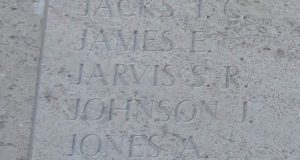
Edward Leach, Private, 2388, Montgomeryshire Yeomanry. Edward was the son of Charles and Elizabeth Leach, of Park Cottage, Leighton. He worked as a cowman prior to enlisting into the Montgomeryshire Yeomanry on 7 September 1914. He served on home service with the 2nd/1st Battalion, Montgomery Yeomanry for over two years before his health began to deteriorate and he was discharged as medically unfit on 10 January 1917 after having been diagnosed with tuberculosis. Edward died in hospital in Newport, Monmouth on 5 September 1918, aged 23. Edward was not previously commemorated by the CWGC, but his case was forwarded to the CWGC as a result of my research, and he was accepted for commemoration by them on Tuesday 25 August 2020. He will be commemorated in the United Kingdom Book of Remembrance at Maidenhead unless the location of his grave can be traced.
Leonard Thomas Manley, Private, 203660, Royal Welsh Fusiliers. Leonard was the son of John and Alice Manley, of Stone House, Trewern. He worked as a Roadman prior to enlisting into the 4th Battalion, Royal Welsh Fusiliers at Welshpool on 25 February 1916. On 11 July 1917 Leonard embarked for Egypt, via Taranto, and disembarked at Alexandria on 29 July, joining the Egyptian Base Depot. On 31 July 1917 Leonard was posted to the 1/6th Battalion, Royal Welsh Fusiliers, which was attached to 158 Brigade, 53rd (Welsh) Division. The Division had recently taken part in the failed Second Battle of Gaza, which had been launched on 17 April, and the EEF had suffered a change in leadership, with Sir Edmund Allenby assuming command, before being re-organised, and a third offensive was launched against a wider front from Beersheba to Gaza on 31 October 1917. This time the Turkish defences were breached, and the road to Jerusalem now lay open and the EEF began to advance north. On 6 November 1917, 158 Brigade launched an attack on the Khuweilfeh Heights. Leonard was posted as missing following the fighting that day, and was reported by his Company Commander to have been killed in action and buried. Leonard was later found to have been taken prisoner by the Turks, and sent to a POW camp at Gelebek, Turkey. He died of dysentery whilst a POW at Paradise Hospital in Smyrna, Mesopotamia on 16 October 1918. The 23-year-old was buried in Baghdad (North Gate) War Cemetery, Iraq.
Harry Sylvanus Meredith, MM, Private, 57670, Machine Gun Corps (Infantry). Harry was the son of John and Catherine Meredith, of Heldre, Uppington. He worked as a farm labourer at Middletown prior to enlisting into the Montgomeryshire Yeomanry at Welshpool soon after the outbreak of war. On 5 August 1914 the Montgomeryshire Yeomanry was mobilised at Welshpool, as part of the South Wales Mounted Brigade, before moving via Hereford to Thetford, to join the 1st Mounted Division. On 4 March 1916 the 1st Mounted Division sailed for Egypt to join the EEF. On 4 March 1917 the battalion merged with the Welsh Horse Yeomanry to form the 25th (Montgomery & Welsh Horse Yeomanry) Battalion, Royal Welsh Fusiliers, as part of the newly formed 231 Brigade, 74th (Yeomanry) Division. The Division assembled in Egypt as part of the EEF, before crossing the Suez Canal into the Sinai, and saw its first major action during the Second Battle of Gaza. The battle was a failure, and the EEF was re-organised under a new commander, Sir Edmund Allenby, before launching the Third Battle of Gaza on the night of 31 October 1917. This assault was launched along a winder front, running from Gaza to Beersheba, and this time the EEF prevailed, opening the door to Jerusalem. The Division then took part in the drive north into Syria, but as a result of the heavy losses suffered in France, following the launching of the three German Spring offensives from 21 March 1918, was sent to France, landing in Marseilles on 7 May 1918. The Division underwent a system of training, to prepare it for the vastly different conditions on the Western Front, before taking over a section of the front in the St. Floris Sector. By now Harry had been transferred to the 74th Battalion, Machine Gun Corps, in the same Division. To the south, the Allies launched their offensive on 21 August 1918, and began the great advance towards the Hindenburg Line. The 74th Division was transferred south to join the offensive and assembled around Beaucourt Chateau before moving forward to the twin towns of Lempire and Ronssoy, to take part in the assault against the outer Hindenburg Line defences there on 18 September, and saw heavy fighting over the coming days. Harry was wounded during the terrible fighting which followed, and died of his wounds on 30 September 1918. The 26-year-old was buried in Doingt Communal Cemetery Extension, France. Harry had been awarded the Military Medal for bravery during his short time in France.
Edward Millington, Private, 25432, South Wales Borderers. Edward was the son of William Edward Millington and Mary Ann Millington, of The Smithy, Buttington. He enlisted into the King’s Shropshire Light Infantry at Welshpool, and after completing his training was posted to France in the Spring of 1917, where he was among a large number of KSLI men posted to the 11th Battalion, South Wales Borderers. The battalion was attached to 115 Brigade, 38th (Welsh) Division, and had been holding the Canal Bank sector at Boesinghe since October 1916, following its assault on Mametz Wood the previous July. On 14 June the 11th SWB marched out of the line to bivouacs in Proven, and began a training programme, then moved further away from the front, to Westrehem, where its training intensified, in preparation for the forthcoming Passchendaele offensive. By 19 July the battalion was back at Proven, and two days later practised an attack at St. Sixte on a scale model of the German trenches they were due to assault. By 30 July the battalion had moved back into the battle zone, and moved into its assembly positions, alongside the other attacking battalions of the 38th Division. The Division had been tasked with the capture of the Pilckem Ridge, which would then bring Langemarck within range, and at dawn on 31 July 1917 the Division launched its assault on the Ridge, gaining its objective along the Steenbeek by the end of the day before digging in and consolidating its gains. Edward was killed in action during the assault that day. The 19-year-old was originally buried on the battlefield, but after the war his grave was exhumed and identified by his pay book in his tunic pocket, before Edward was re-interred in Poelcapelle British Cemetery, Belgium on 5 October 1920.
George Morris, Private, 31109, South Lancashire Regiment. George was born at Berriew in 1899, the son of Joseph and Jane Morris. He lived with his uncle and aunt, George and Mary Rogers, at Cefn, Buttington prior to the war. George enlisted into the 4th Battalion, King’s Shropshire Light Infantry (Territorials) at Shrewsbury, and after completing his training was posted to France in the Summer of 1916, and transferred to the 2nd Battalion, South Lancashire Regiment. He possibly joined the battalion in the Écoivres area, where it was attached to 7 Brigade, 25th Division, which had held that sector since arriving in France the previous September. On 1 June the 2nd South Lancs moved out of the area, and the entire Division moved to Bethencourt, to train before moving to the Somme sector at the end of the month, reaching Hedauville by 30 June. On the following morning, 1 July 1916, the Allies launched the Battle of the Somme, and two days later the 25th Division moved into the line to continue the attack on Thiepval Ridge. The Division fought throughout the Battle of the Somme, and then moved to Ploegsteert, where it held the line for the months leading up the Battle of Messines in June 1917. After fighting at Messines, the Division moved to the Railway Wood sector and took part in the Battle of the Pilckem Ridge, before relieved in the middle of September, and moved to Sains en Gohelle before taking over positions on the La Bassée Canal. By the beginning of December, the Division had moved further south, to the Somme sector, before taking over positions facing the Hindenburg Line near Bullecourt. The Germans launched the opening phase of their Spring Offensive here on 21 March 1918, along the section of front running south from Croisilles to La Fère, and broke through the Allied lines. The 25th Division received orders to Stand-To and prepare to move forward and in the afternoon moved into the Vaulx-Morchies Line. The Division was hit hard by the Germans on the following day, and furious fighting ensued, before the Division was forced to withdraw under the ferocious onslaught. George was killed in action during this terrible day, 22 March 1918. The 18-year-old has no known grave and is commemorated on the Pozieres Memorial, France.
John Morris, Private, 8804, Royal Welsh Fusiliers. John was the son of William Field Morris and Jane Morris (nee Horley), of Cefn, Buttington. He had enlisted into the 2nd Battalion, Royal Welsh Fusiliers as a young man, and by 1911 was in India with the battalion. The battalion had returned to England prior to the war, and was at Portland when war was declared, embarking for France on 13 August 1914. The battalion was initially placed on Lines of Communication at Rouen, before joining 19 Brigade at Valenciennes, taking part in the retreat to the Marne with the BEF. Following the Battles of the Marne and the Aisne, 19 Brigade moved to Flanders with the BEF, and eventually took over the La Boutillerie sector after becoming attached to the 6th Division. The Division then spent several months at Bois-Grenier, then on 31 May 1915, 19 Brigade transferred to the 27th Division. The Brigade was then temporarily attached to the 2nd Division on 19 August, taking part in the Battle of Loos, and subsequent Action of Hohenzollern Redoubt, before joining the newly arrived 33rd Division on 25 November 1915. The Division endured a hard time during its first few months in the line, holding such notorious sectors as Cambrin and Cuinchy, where underground warfare was prevalent. On 22 June 1916 the Germans exploded a massive mine beneath the position held by B Company, 2nd RWF, which killed 54 men of the battalion, as well as trapping a number of British tunnellers underground. During the attempted rescue of one tunneller, a soldier of the 14th Welsh, Sapper Hackett was awarded the VC. At the beginning of July, the 33rd Division moved out of the sector and began to move into the Somme area. By 16 July the 2nd RWF were bivouacked in the newly captured Mametz Wood, and moved to Bazentin-le-Petit two days later, to take part in the assault on High Wood. John was killed in action when the 2nd RWF came under heavy artillery fire here on 18 July 1916, on the morning before the assault on High Wood. The 28-year-old has no known grave and is commemorated on the Thiepval Memorial, France.
William Thomas Nichols, Private, 16716, Essex Regiment. William was the son of Alfred and Elizabeth Nichols, of Buttington. He had moved to London as a young man, and on 11 September 1905 married Harriet Heathfield, at St. Andrew’s, Haverstock Hill. By 1911 the couple were living at 64, Manor Park Road, East Finchley, where William worked as a Grocer’s Assistant. He enlisted at East Ham into the Essex Regiment soon after the outbreak of war. William embarked for France on 25 May 1915, joining the 2nd Battalion, Essex Regiment, which was at Shell Trap Farm, near Wieltje, in the Ypres Salient attached to 12 Brigade, 4th Division. On 31 May, 12 Brigade was relieved from the front line and moved to billets to rest. On 6 June the Brigade relieved a French Division in support trenches at Turco Farm, before the 2nd Essex moved to Elverdinghe Chateau before being forced to move into the front line a day early, replacing another battalion which had been instead diverted to other work. The following days were relatively quiet; however, William was unfortunately the sole man killed in action in the battalion whilst it was holding the line on 8 June 1915. The 33-year-old was originally buried on the battlefield, but his grave was exhumed after the war, and he was re-interred in New Irish Farm Cemetery, Belgium on 21 August 1919.
William John Parry, Sergeant, 355190, Royal Welsh Fusiliers. William was the son of John Parry and Mary Ann Parry (nee Hughes), of Lacon Villa, Criggion, Alberbury. He resided at Heldre Hall, Buttington prior to enlisting into the 1/1st Battalion, Montgomeryshire Yeomanry at Welshpool on 26 August 1914. The Montgomeryshire Yeomanry had been mobilised at Welshpool at the outbreak of war, as part of the South Wales Mounted Brigade, before moving via Hereford to Thetford, to join the 1st Mounted Division. On 4 March 1916 the 1st Mounted Division sailed for Egypt to join the EEF. On 4 March 1917 the battalion merged with the Welsh Horse Yeomanry to form the 25th (Montgomery & Welsh Horse Yeomanry) Battalion, Royal Welsh Fusiliers, as part of the newly formed 231 Brigade, 74th (Yeomanry) Division. The Division assembled in Egypt as part of the EEF, before crossing the Suez Canal into the Sinai, and saw its first major action during the Second Battle of Gaza. The battle was a failure, and the EEF was re-organised under a new commander, Sir Edmund Allenby, before launching the Third Battle of Gaza on the night of 31 October 1917. This assault was launched along a winder front, running from Gaza to Beersheba, and this time the EEF prevailed, opening the door to Jerusalem. Due to the terrible casualties suffered by the British on the Western Front in March and April 1918 the Division was recalled to the Western Front, and arrived at Marseilles during May 1918. The Division trained near Le Cauroy before taking over positions in the St. Floris Sector, moving into the front line between the La Bassée Canal and the River Lys, with the left resting on the small village of Corbie. The Division faced the recently lost town of Merville, some 3,000 yards away. To the south, the Allies launched their offensive on 21 August 1918, and began the great advance towards the Hindenburg Line. The 74th Division was transferred south to join the offensive and assembled around Beaucourt Chateau before moving forwards to the area around the twin villages of Lempire and Ronssoy, launching an assault against the outer Hindenburg Line defences on 18 September. After suffering heavy casualties, the Division was relieved and entrained at Péronne for Northern France, taking over a section of front line near Hinges on 2 October. Over the coming days the Division began to advance, joining the Great Advance in Flanders, and began to push the Germans back towards the Belgian frontier. By 17 October the Division had reached Faches, and on the following day took the village of Sainghin, before crossing the River Marcq, before pushing forwards to the village of Camphin. William was killed in action near Camphin on the following day, 20 October 1918. The 27-year-old is buried in Lamain Communal Cemetery, Belgium.
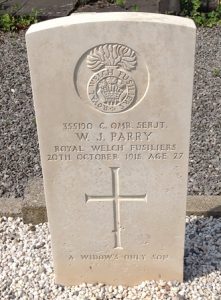
Edward Ernest Poole, Corporal, D/3085, 3rd Dragoon Guards (Prince of Wales’ Own). Edward was born at Buttington in 1887, the son of Police Sergeant John Poole and Margaret Poole. By 1895 the family had moved away from the village, first to Llanfair Caereinion, then to Welshpool by 1901. Edward worked as a Groom prior to enlisting into the 3rd Dragoon Guards at Welshpool on 4 March 1909, and by 1911 was based at Aldershot with the regiment. His parents had by now moved to Railway Rank, Cwmbelan, Llanidloes. Edward was in Cairo with the 3rd Dragoons at the outbreak of war, and on 29 September sailed from Alexandria with the regiment. After a brief period in England, the 3rd Dragoons landed in France on 31 October 1914, entraining from Le Havre to Cassel, joining the 6th Cavalry Brigade, 3rd Cavalry Division. The Division took up defensive positions east of Ypres with the BEF, at Zillebeke by 13 November, and assisted the BEF with the defence of the ancient city, seeing heavy casualties over the coming days. Edward was wounded at Zillebeke, and was evacuated to Poperinghe, where he died of his wounds on 20 November 1914. The 27-year-old was buried in Poperinghe Old Military Cemetery, Belgium. Edward is not commemorated on the Buttington war memorial, but at Llangurig.
John William Powell, Private, 55489, Royal Welsh Fusiliers. John was the son of Thomas and Fanny Powell, of The Bushes, Hope, Leighton. He enlisted into the Montgomeryshire Yeomanry at Welshpool soon after the outbreak of war, and was posted to the 3/1st Battalion at Park Hall Camp, Oswestry for training. John was drafted to France in the Winter of 1916-17, and joined the 5th Infantry Base Depot at Rouen. He was then transferred to the 17th Battalion, Royal Welsh Fusiliers, which was in the Canal Bank sector at Ypres, attached to 115 Brigade, 38th (Welsh) Division. The Division had moved there in September 1916 following its famous assault on Mametz Wood. The infantry battalions of the Division then began carrying out the normal pattern of rotation in the trenches, four days in the front, four in support and four in reserve, whilst also working on trench improvement, digging new trenches, and also carrying out regular patrols and trench raids. On 31 July 1917 the Division launched its famous assault on the Pilckem Ridge, capturing Iron Cross and reaching its objective of the Steenbeek, then played a supporting role in the Battle of Langemarck. The Division was transferred to the Sailly-sur-la-Lys sector in September, and remained in the area over the winter before being moved to positions north of Albert, at Bouzincourt Ridge, at the end of March 1918, relieving the battered 2nd and 47th Divisions. It held this sector, again carrying out minor operations and trench raids, over the coming months. On 8 May 1918 the 17th RWF moved into the front line on Bouzincourt Ridge, to begin a routine tour. John was killed in action during this routine tour, on 13 May 1918. The 28-year-old was buried in Bouzincourt Communal Cemetery Extension, France.
George Ernest Pritchard, Gunner, 37040, Royal Field Artillery. George was born at Buttington in 1887, the son of William and Elizabeth Pritchard. His father died in 1903, and George went to Live in Manchester, gaining work as a labourer soon afterwards. He enlisted at Manchester into the Royal Field Artillery on 30 March 1905, signing up for three years’ service, and after completing his service joined the Army Reserve, moved initially to Lunesdale, Lancashire, where he had gained work as a postman, and married Emily Pilling in the summer of 1909. By 1911 the couple were residing at Bolton Row, Brookhouse, Caton, Lunesdale, then in 1913 the couple moved to Keighley, where George had been transferred, and their only son, William Haughton Pritchard, was born there on 5 November 1913. Following the outbreak of war, George was mobilised from the Army Reserve, and embarked for France on 13 September 1914, joining the 114th Battery, 25th Brigade, Royal Field Artillery, which was attached to the 1st Division. The Division had been one of the first to arrive in France, fighting at the Battle of Mons, and taking part in the retreat to the Marne, where the Germans were stopped. They then fought at the Aisne, and at Chivy, before being moved north to Ypres. George joined the Brigade on the Aisne, at Moulins. On 16 October the Brigade entrained for Northern France, reaching St. Omer on the night of 18-19 October and marched to Cassel. Within two days the Brigade had set up its guns at Boesinghe. The Division then fought at the First Battle of Ypres, where it helped stem the German drive towards the Channel coast, before wintering in Flanders. The following year saw the Division in action again at the Battle of Aubers, before moving South to Loos, taking part in the Battle of Loos, and the action at the Hohenzollern redoubt. During the first week of July 1916 the Division moved south to the Somme, to join the great Somme offensive, and the Brigade reached Becordel-Becourt by 14 July, setting up its guns to support the attacking infantry on Bazentin Ridge. As the front-line inched forwards, the Brigade also moved slowly forwards, taking up positions east of Mametz Wood the following day, and then moved to Shelter Wood, to support the assault on High Wood. By 23 July the Brigade had moved to Caterpillar Wood, where it continued its work over the coming days. On 27 July 1916 the Brigade was in action at Caterpillar Valley, firing on targets at the junction of Munster Alley and OG1, when George and another man were killed by German counter-battery fire. The 30-year-old has no known grave and is commemorated on the Thiepval Memorial, France. His brother John had died just three months earlier.
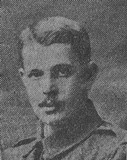
John Pritchard, Private, 20393, Duke of Cornwall’s Light Infantry. John was born at Cefn, Buttington in 1889, the son of William and Elizabeth Pritchard. He was working in South Wales at the outbreak of war, and enlisted at Porth, Rhondda into the 7th Battalion, Somerset Light Infantry. He was then posted to France on 14 May 1915, and was transferred to the 2nd Battalion, Duke of Cornwall’s Light Infantry, which was attached to 82 Brigade, 27th Division. John joined the battalion at Ypres, where the Division was holding the line at Sanctuary Wood. The Division had seen heavy fighting during the Actions of the St. Eloi craters over the preceding months, and then during the Second Battle of Ypres, which was still raging when John arrived. The 2nd DCLI was relieved from the front line on 23 May and moved to a camp near Poperinghe to rest and rebuild before moving south to the Armentieres, taking over the front line east of the town at Le Bizet by 27 May. The Division then enjoyed a relatively uneventful few months, before being transferred to Salonika in November 1915, entraining for Marseilles before sailing for this new theatre of war, and arrived on 5 December. The British and French had sent a number of Divisions to Salonika following the invasion of Serbia by a combined Austrian and Bulgarian offensive, which had forced the Serbian Army to retreat into Greece. John took ill within months of landing in Salonika, and was evacuated aboard the Hospital Ship Carisbrook Castle, where he died on 27 April 1916. The 26-year-old was buried at sea, and so is commemorated on the Doiran Memorial, Greece. His brother, George, was killed just three months later.
Albert Edward Ramsbotham, Private, 54856, Royal Fusiliers. Albert was the son of Joseph Ramsbotham and Sarah Ann Ramsbotham (nee Hughes), of Blackley, Lancashire. His mother was from Buttington, and Albert was raised by her parents at New House, Buttington. After leaving school, Albert returned to Lancashire, and married Clara French in 1911, before the couple set up home at 20, Sapphire Street, Blackley, Manchester. Albert enlisted into the army at Manchester, and was posted to France, joining the 8th Battalion, Royal Fusiliers on 26 July 1916. The battalion was on the Somme, attached to 36 Brigade, 12th (Eastern) Division, and was taking part in the Battle of Pozieres when Albert arrived. He was not with the battalion long, as on 4 August 1916 Albert was transferred to the 24th Battalion, Royal Fusiliers, which was also on the Somme, attached to 5 Brigade, 2nd Division. He served with the battalion until 10 October, when he appears to have returned to England. Upon his return he was posted to the 23rd Battalion, Royal Fusiliers, joining the battalion on 20 March 1917, but on 8 April 1917 was posted to C Company of the 7th Battalion, Royal Fusiliers. The battalion was attached to 190 Brigade, 63rd (Royal Naval) Division, and was at Hallecourt, in the Arras sector, when Albert joined its ranks. On 14 April 1917 the 63rd Division relieved the 34th Division in the line near Roclincourt, where it prepared to take part in the Battle of Arras. The Division then fought at the Second Battle of the Scarpe, where it captured the village of Gavrelle on 23 April. At the end of April, the 7th Royal Fusiliers were relieved and moved to huts in Ecurie, and spent ten days there before moving to Écoivres, to carry out a training programme. On 18 May the battalion moved back into the front-line area, then by 1 June had taken over positions at Oppy, on the Hindenburg Line, remaining here over the coming weeks. On 5 July 1917 the battalion was in the front line at Oppy, with three Companies working on Oppy Trench, when their positions came under artillery fire. Albert was killed in action here during the day. The 28-year-old is buried in Albuera Cemetery, Bailleul-Sire-Berthoult, France. Interestingly, two of his brothers, Allen Gwilliam Ramsbotham and William Leonard Ramsbotham, gained the award of the Military Medal during the war, whilst serving with the Royal Engineers. William Leonard later served with the Royal Navy, and was lost aboard HMS Hood in 1940.
Evan Roberts, Company Quartermaster Sergeant, 355013, Royal Welsh Fusiliers. Evan was the son of Evan and Fanny Roberts, of Hope Farm, Leighton. He worked on his parent’s farm prior to enlisting into the Montgomeryshire Yeomanry at Welshpool on 8 April 1908, and over the coming years attended every annual TA summer camp, being promoted to Sergeant by 1913. On 5 August 1914 the Montgomeryshire Yeomanry was mobilised at Welshpool, as part of the South Wales Mounted Brigade, before moving via Hereford to Thetford, to join the 1st Mounted Division. On 4 March 1916 the 1st Mounted Division sailed for Egypt to join the EEF. On 4 March 1917 the battalion merged with the Welsh Horse Yeomanry to form the 25th (Montgomery & Welsh Horse Yeomanry) Battalion, Royal Welsh Fusiliers, as part of the newly formed 231 Brigade, 74th (Yeomanry) Division. The Division assembled in Egypt as part of the EEF, before crossing the Suez Canal into the Sinai, and saw its first major action during the Second Battle of Gaza. The battle was a failure, and the EEF was re-organised under a new commander, Sir Edmund Allenby, before launching the Third Battle of Gaza on the night of 31 October 1917. This assault was launched along a winder front, running from Gaza to Beersheba, and this time the EEF prevailed, opening the door to Jerusalem. The Division then took part in the drive north into Syria over the coming months. Evan took ill just after the New Year of 1918, and was hospitalised in Jerusalem, where he died of pericarditis on 31 January 1918. The 39-year-old was buried in Jerusalem War Cemetery, Israel.
Charles Edward Thomas, Private, 65269, Welsh Regiment. Charles was the son of John and Margaret Thomas of Old Shop, Trewern. He worked as a farm labourer at Trewern House Farm prior to enlisting into the 62nd Training Reserve Battalion at Welshpool on 5 May 1917, and was posted to Kinmel Park for training. On 30 March 1918 Charles embarked for France, initially destined for the 2nd Battalion, Welsh Regiment, but instead he was posted to the 9th Battalion, Welsh Regiment, which was attached to 58 Brigade, 19th (Western) Division, and had suffered heavy casualties during the fighting which followed the launching of the first phase of the German Spring offensive on 21 March 1918. The 9th Welsh had been almost annihilated during a gallant stand at the village of Beugny, which allowed the remainder of the Division to withdraw, in the face of a ferocious German onslaught. Charles joined up with the 9th Welsh on 7 April, by which time the 19th Division had been evacuated from the Somme to the Messines sector, and was in positions near Neuve Eglise, resting, rebuilding and training. Unfortunately, the Germans launched the second phase of their offensive along the Lys Valley on 9 April, and broke through in the section held by the Portuguese, so the 19th Division was ordered forwards to attempt to plug the gap, taking over positions near Onraet Wood by 10 April, where it awaited the German onslaught once again. The Germans bombarded the Divisions lines throughout the day, before launching an infantry assault, and over the coming days the Division was once again plunged into severe fighting. On 21 April the battered Division was withdrawn and moved to Proven, before taking up positions in the Vlamertinghe-Hallebast Line, then on 17 May the Division entrained for the Aisne sector to rest and rebuild. Unfortunately for the 19th Division, the Germans launched the third, and final, phase of their offensive in this sector on 27 May, so the 19th Division was moved forwards again to meet the onslaught, reaching Bligny by 29 May. The 9th Welsh initially remained in reserve, but on the following morning, 30 May 1918, the front-line troops, the 9th RWF and 8th Gloucester’s, were forced to withdraw through the 9th Welsh after suffering heavy casualties again, and the 9th Welsh then came under attack. Charles was posted as missing during the terrible fighting that day, but was later found to have been killed. The 19-year-old is buried in Chambrecy British Cemetery, France.
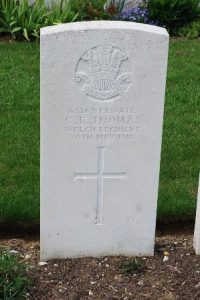
Bertram George Turner, Corporal, 11449, Leicestershire Regiment. Bertram was the son of William and Caroline Jane Turner (nee Kearn), of Laburnum Cottage, Trewern. He worked as a farm servant at Peckleton Manor, Leicestershire prior to the war. Bertram enlisted into the 3rd Battalion, Leicestershire Regiment at Hinckley on 11 August 1914, having already served for a period with the Montgomeryshire Yeomanry prior to the war. He embarked for France on 18 January 1915, and joined the 2nd Battalion, Leicestershire Regiment, which had landed in Marseilles on 12 October 1914 after being recalled from India, and was attached to the Garhwal Brigade, 7th Meerut Division. Bertram joined the battalion at Calonne-Sur-La-Lys, where it was preparing to move into the front line at Rue Du Bois, taking over the line there on 25 January. The Meerut Division held the line here over the coming weeks, and saw its first major action during the Battle of Neuve Chapelle, which was launched on 10 March 1915. The battle saw the Garhwal Brigade’s Indian battalions held up by uncut wire, but the 2nd Leicester’s drove through the German defences on the right flank, capturing the village, and saw Private William Buckingham, of the battalion, awarded the Victoria Cross. The Leicester’s were relieved on 14 March, and went into reserve billets. The Division’s next major action was during the Battle of Aubers Ridge on 9 May, but this attack was a failure, due to inadequate artillery support. The Division remained in the same sector over the summer, and during the first weeks of September, the 2nd Leicester’s were billeted around Port Arthur, spending their nights digging trenches. On 24 September the battalion moved into assembly positions from Pont du Hem, and at dawn on 25 September 1915 launched a diversionary attack, to attempt to draw enemy attention away from the main Battle of Loos, just to the south. Bertram was killed in action during the attack that day. The 31-year-old has no known grave and is commemorated on the Loos Memorial, France. A younger brother, Richard Edward Turner, had been shot in the leg at Neuve-Chapelle, which resulted in its amputation, while their foster-brother, Christopher John Russell, was killed during World War Two.
Charles Albert Williams, Private, 72647, The King’s (Liverpool Regiment). Charles was born at Buttington in 1899, the son of John Lloyd Williams, and Mary Williams. The family had moved to Kynsal Heath, Audlem by 1905, where John had found work as a farm labourer. Charles enlisted into the Army at Prees Heath, and was posted to the 21st Labour Battalion, The King’s (Liverpool Regiment), which was based at Prees Heath Camp. Charles did not serve overseas during the war, but remained at Prees Heath, however he unfortunately caught influenza there, and died in hospital at the camp on 9 October 1918. The remains of the 19-year-old were buried in Audlem Cemetery, Cheshire. Charles is not commemorated on the Buttington war memorial.
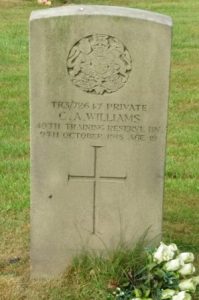
World War Two, 1939-1945
George Robert Jepson, Lance Corporal, 4194379, Highland Light Infantry. George was the son of Peter Baguley Jepson and Ann Jepson (nee Jones), of Buttington. He enlisted into the Royal Welch Fusiliers, but at some time afterwards was transferred to the 1st Battalion, Highland Light Infantry, which was known as the Glasgow Highlanders. George married Elizabeth Mary Jones in Anglesey in 1943. The battalion had been in France with the BEF in 1940, but upon its return, was transferred to 71 Brigade, 53rd (Welsh) Division in October 1943, and it would have been after this that George was posted to the battalion. The Division embarked for Normandy at the end of June 1944, taking part in the break-out from the Normandy beach-head, and then in the subsequent drive north-east through France and Belgium into Holland. George was killed whilst 71 Brigade was fighting near Middelbeers and Oostelbeers on 24 September 1944. The 30-year-old is buried in Mierlo War Cemetery, Netherlands. The memorial in the Churchyard states Robert John Jepson, but no man of that name is recorded as having fallen during the war.
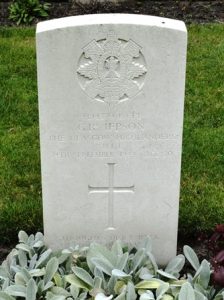
William Leonard Ramsbotham, MM, Shipwright 4th Class, P/MX67742, Royal Navy. William, known as Leonard, was born in Blackley, Lancashire on 17 September 1897, the youngest child of Joseph Ramsbotham and Sarah Ann Ramsbotham (nee Hughes). His mother was from Buttington, and the family often visited Sarah’s widowed mother in the village. Leonard enlisted into the Royal Welsh Fusiliers following the outbreak of the Great War, but was transferred to the Royal Engineers, gaining the award of the Military Medal, for bravery, during the war. Leonard emigrated to Canada after the war, and lived in Vancouver, but returned to England when his mother fell ill. She died at Buttington in 1932, and is buried there. Leonard remained in England, enlisting into the Royal Navy, and by the time that the Second World War broke out, he was serving aboard the battlecruiser HMS Hood. She had been built during the Great War, and for twenty years had been the largest warship in the world. As a result, Hood was very well known around the globe0, and was known as “The Mighty Hood”. She was due a major upgrade in 1939, but the outbreak of war led to the work being cancelled, and Hood was pressed into service in the North Atlantic, patrolling around Iceland and hunting for German raiders. During May 1941, Hood and the battleship Prince of Wales were ordered to intercept the German battleship Bismarck and the heavy cruiser Prinz Eugen, which were en route to the Atlantic, hoping to wreak havoc on the vitally important Atlantic Convoys. On 24 May 1941, Hood encountered the two German battlecruisers in the Denmark Strait, and the might ships began exchanging fire. Less than ten minutes later, a German shell penetrated the thinly armoured deck of HMS Hood, triggering a cataclysmic explosion in her magazines which broke the back of Hood, sending her to the bottom in less than three minutes. All but three men of her crew of 1,418 were killed in her sinking. Leonard was 43-years-old when he was killed that day, and is commemorated on the Portsmouth Naval Memorial, Hampshire.

Christopher John Russell, Private, 1830028, Durham Light Infantry. Christopher was born at Craven Arms on 3 June 1907, the son of Edith Elsie Russell. He was fostered by William and Caroline Jane Turner (nee Kearn), of Laburnum Cottage, Trewern by 1911. Christopher enlisted into the Army and was posted to the 9th Battalion, Durham Light Infantry. The battalion was attached to the 151st Brigade, 50th Division, and had been in France with the BEF in 1940, taking part in the heavy fighting around Arras, before the survivors were evacuated from Dunkirk. The Division then rebuilt before embarking for North Africa, taking part in the campaign in the Western Desert against the Italians and the Afrika Korps, taking part in the successful Second Battle of El Alamein, and after this the Division was withdrawn and sent to Alexandria to refit, before training in amphibious techniques for the invasion of Sicily. The 151st brigade had been chosen as an assault brigade for the invasion of Sicily on 10 July 1943, and saw heavy fighting against an elite German paratrooper regiment. The 50th Division then received orders to return to Britain to train for the forthcoming invasion of Europe. The Division landed in the second wave on Gold Beach King sector, and saw heavy fighting as it advanced inland. Following the break-out from the Falaise Pocket, the Division crossed the Seine, and took part in the advance through Northern France into Belgium and Holland over the coming weeks. By October the Division had been moved to the ‘Island’, the low-lying ground between the Wall and the Lower Rhine north of Eindhoven, and took part in the fighting to expand the bridgehead. Christopher was killed here on 4 October 1944. The 36-year-old was originally buried in a small cemetery near to when he fell, but in September 1945 the cemetery was exhumed, and all of the military burials were moved into Arnhem Oosterbeek War Cemetery, Netherlands. His foster-brother, Bertram George Turner, was killed during the Great War.
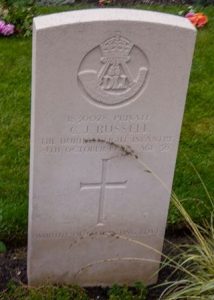
William Henry Roberts Trow, Bombardier, 952375, Royal Artillery. William was the son of William Henry Trow and Emily Trow (nee Roberts), of Hope Cottage, Leighton. He enlisted into the Army and was posted to the 153rd (The Leicestershire Yeomanry) Field Regiment, Royal Artillery. The Regiment was a Territorial Army unit, which was still mounted at the outbreak of war, joining the 6th Cavalry Brigade, 1st Cavalry Division. In April 1940 the regiment was converted to a Field Artillery unit, and became attached to the Guards Armoured Division, being part of the Guards Support Group. The Division remained in Britain for most of the war, until it began landing units at Arromanches from 13 June 1944, and saw its first major action during Operation Goodwood from 18-20 July, an attack by three armoured divisions in an attempt to break out of the Normandy beachhead. The next major offensive was during Operation Bluecoat, from 30 July, the advance east of Caen as the Falaise pocket formed. William was killed during Operation Bluecoat, on 3 August 1944. The 25-year-old is buried in St. Charles De Percy War Cemetery, France.
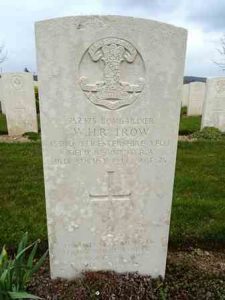
Iraq, Op Telic
Paul David Trevor Thomas, Corporal, 25051544, The Light Infantry. Paul was born on 25 January 1975, and resided at Buttington. He enlisted into the 2nd Battalion, The Light Infantry aged 19, and was posted to the Middle East to take part in Op Telic, the invasion of Iraq, in 2003, attached to the 19th Mechanised Brigade. After the fall of Iraq, Paul was attached to the 1st Battalion, the Cheshire Regiment, which was on security duties in Iraq. He was killed when his unit was attacked by a large number of heavily armed gunmen in Basra on 17 August 2004. The body of the 29-year-old was flown back to RAF Brize Norton, and he was buried in Castle Caereinion Cemetery.